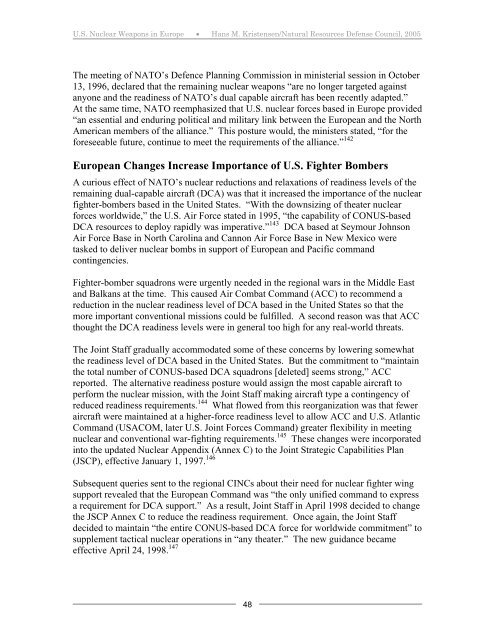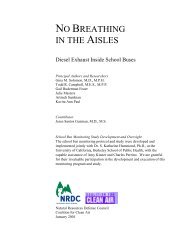US Nuclear Weapons in Europe - Natural Resources Defense Council
US Nuclear Weapons in Europe - Natural Resources Defense Council
US Nuclear Weapons in Europe - Natural Resources Defense Council
Create successful ePaper yourself
Turn your PDF publications into a flip-book with our unique Google optimized e-Paper software.
U.S. <strong>Nuclear</strong> <strong>Weapons</strong> <strong>in</strong> <strong>Europe</strong> • Hans M. Kristensen/<strong>Natural</strong> <strong>Resources</strong> <strong>Defense</strong> <strong>Council</strong>, 2005<br />
The meet<strong>in</strong>g of NATO’s Defence Plann<strong>in</strong>g Commission <strong>in</strong> m<strong>in</strong>isterial session <strong>in</strong> October<br />
13, 1996, declared that the rema<strong>in</strong><strong>in</strong>g nuclear weapons “are no longer targeted aga<strong>in</strong>st<br />
anyone and the read<strong>in</strong>ess of NATO’s dual capable aircraft has been recently adapted.”<br />
At the same time, NATO reemphasized that U.S. nuclear forces based <strong>in</strong> <strong>Europe</strong> provided<br />
“an essential and endur<strong>in</strong>g political and military l<strong>in</strong>k between the <strong>Europe</strong>an and the North<br />
American members of the alliance.” This posture would, the m<strong>in</strong>isters stated, “for the<br />
foreseeable future, cont<strong>in</strong>ue to meet the requirements of the alliance.” 142<br />
<strong>Europe</strong>an Changes Increase Importance of U.S. Fighter Bombers<br />
A curious effect of NATO’s nuclear reductions and relaxations of read<strong>in</strong>ess levels of the<br />
rema<strong>in</strong><strong>in</strong>g dual-capable aircraft (DCA) was that it <strong>in</strong>creased the importance of the nuclear<br />
fighter-bombers based <strong>in</strong> the United States. “With the downsiz<strong>in</strong>g of theater nuclear<br />
forces worldwide,” the U.S. Air Force stated <strong>in</strong> 1995, “the capability of CON<strong>US</strong>-based<br />
DCA resources to deploy rapidly was imperative.” 143 DCA based at Seymour Johnson<br />
Air Force Base <strong>in</strong> North Carol<strong>in</strong>a and Cannon Air Force Base <strong>in</strong> New Mexico were<br />
tasked to deliver nuclear bombs <strong>in</strong> support of <strong>Europe</strong>an and Pacific command<br />
cont<strong>in</strong>gencies.<br />
Fighter-bomber squadrons were urgently needed <strong>in</strong> the regional wars <strong>in</strong> the Middle East<br />
and Balkans at the time. This caused Air Combat Command (ACC) to recommend a<br />
reduction <strong>in</strong> the nuclear read<strong>in</strong>ess level of DCA based <strong>in</strong> the United States so that the<br />
more important conventional missions could be fulfilled. A second reason was that ACC<br />
thought the DCA read<strong>in</strong>ess levels were <strong>in</strong> general too high for any real-world threats.<br />
The Jo<strong>in</strong>t Staff gradually accommodated some of these concerns by lower<strong>in</strong>g somewhat<br />
the read<strong>in</strong>ess level of DCA based <strong>in</strong> the United States. But the commitment to “ma<strong>in</strong>ta<strong>in</strong><br />
the total number of CON<strong>US</strong>-based DCA squadrons [deleted] seems strong,” ACC<br />
reported. The alternative read<strong>in</strong>ess posture would assign the most capable aircraft to<br />
perform the nuclear mission, with the Jo<strong>in</strong>t Staff mak<strong>in</strong>g aircraft type a cont<strong>in</strong>gency of<br />
reduced read<strong>in</strong>ess requirements. 144 What flowed from this reorganization was that fewer<br />
aircraft were ma<strong>in</strong>ta<strong>in</strong>ed at a higher-force read<strong>in</strong>ess level to allow ACC and U.S. Atlantic<br />
Command (<strong>US</strong>ACOM, later U.S. Jo<strong>in</strong>t Forces Command) greater flexibility <strong>in</strong> meet<strong>in</strong>g<br />
nuclear and conventional war-fight<strong>in</strong>g requirements. 145 These changes were <strong>in</strong>corporated<br />
<strong>in</strong>to the updated <strong>Nuclear</strong> Appendix (Annex C) to the Jo<strong>in</strong>t Strategic Capabilities Plan<br />
(JSCP), effective January 1, 1997. 146<br />
Subsequent queries sent to the regional CINCs about their need for nuclear fighter w<strong>in</strong>g<br />
support revealed that the <strong>Europe</strong>an Command was “the only unified command to express<br />
a requirement for DCA support.” As a result, Jo<strong>in</strong>t Staff <strong>in</strong> April 1998 decided to change<br />
the JSCP Annex C to reduce the read<strong>in</strong>ess requirement. Once aga<strong>in</strong>, the Jo<strong>in</strong>t Staff<br />
decided to ma<strong>in</strong>ta<strong>in</strong> “the entire CON<strong>US</strong>-based DCA force for worldwide commitment” to<br />
supplement tactical nuclear operations <strong>in</strong> “any theater.” The new guidance became<br />
effective April 24, 1998. 147<br />
48
















